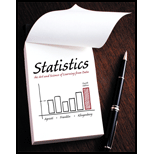
Concept explainers
Female for president? When recent General Social Surveys have asked, “If your party nominated a woman for president, would you vote for her if she were qualified for the job?” about 94% of females and 94% of males answered yes, the rest answered no. (Source: Data from CSM, UC Berkeley.)
- a. For males and for females, report the conditional distributions on this response variable in a 2 × 2 table, using outcome categories (yes, no).
- b. If results for the entire population are similar to these, does it seem possible that gender and opinion about having a woman president are independent? Explain.
a.
Report conditional distributions in a
Answer to Problem 47CP
The 2×2 contingency table of given data is given below.
| Course | Vote | Total | |
| Yes | No | ||
| Female | 94% | 6% | 100% |
| Male | 94% | 6% | 100% |
Explanation of Solution
It is given that 94% of females and 94% of males said, they vote if the party nominated a woman for president.
The 2×2 contingency table of given data is given below.
| Course | Vote | Total | |
| Yes | No | ||
| Female | 94% | 100% | |
| Male | 94% | 100% | |
b.
Explain whether gender and opinion about having a woman president are independent.
Explanation of Solution
Two variables are said to be independent, if the population conditional distributions of variables are same.
From the given information it is observed that about 94% of males and 94% females answered yes for the given question.
Since, it is same for both male and female, it seems possible that gender and opinion about having a woman president are independent.
Want to see more full solutions like this?
Chapter 11 Solutions
Statistics: The Art and Science of Learning from Data (4th Edition)
- Should you be confident in applying your regression equation to estimate the heart rate of a python at 35°C? Why or why not?arrow_forwardGiven your fitted regression line, what would be the residual for snake #5 (10 C)?arrow_forwardCalculate the 95% confidence interval around your estimate of r using Fisher’s z-transformation. In your final answer, make sure to back-transform to the original units.arrow_forward
- BUSINESS DISCUSSarrow_forwardA researcher wishes to estimate, with 90% confidence, the population proportion of adults who support labeling legislation for genetically modified organisms (GMOs). Her estimate must be accurate within 4% of the true proportion. (a) No preliminary estimate is available. Find the minimum sample size needed. (b) Find the minimum sample size needed, using a prior study that found that 65% of the respondents said they support labeling legislation for GMOs. (c) Compare the results from parts (a) and (b). ... (a) What is the minimum sample size needed assuming that no prior information is available? n = (Round up to the nearest whole number as needed.)arrow_forwardThe table available below shows the costs per mile (in cents) for a sample of automobiles. At a = 0.05, can you conclude that at least one mean cost per mile is different from the others? Click on the icon to view the data table. Let Hss, HMS, HLS, Hsuv and Hмy represent the mean costs per mile for small sedans, medium sedans, large sedans, SUV 4WDs, and minivans respectively. What are the hypotheses for this test? OA. Ho: Not all the means are equal. Ha Hss HMS HLS HSUV HMV B. Ho Hss HMS HLS HSUV = μMV Ha: Hss *HMS *HLS*HSUV * HMV C. Ho Hss HMS HLS HSUV =μMV = = H: Not all the means are equal. D. Ho Hss HMS HLS HSUV HMV Ha Hss HMS HLS =HSUV = HMVarrow_forward
 Holt Mcdougal Larson Pre-algebra: Student Edition...AlgebraISBN:9780547587776Author:HOLT MCDOUGALPublisher:HOLT MCDOUGAL
Holt Mcdougal Larson Pre-algebra: Student Edition...AlgebraISBN:9780547587776Author:HOLT MCDOUGALPublisher:HOLT MCDOUGAL
 Glencoe Algebra 1, Student Edition, 9780079039897...AlgebraISBN:9780079039897Author:CarterPublisher:McGraw Hill
Glencoe Algebra 1, Student Edition, 9780079039897...AlgebraISBN:9780079039897Author:CarterPublisher:McGraw Hill College Algebra (MindTap Course List)AlgebraISBN:9781305652231Author:R. David Gustafson, Jeff HughesPublisher:Cengage Learning
College Algebra (MindTap Course List)AlgebraISBN:9781305652231Author:R. David Gustafson, Jeff HughesPublisher:Cengage Learning




